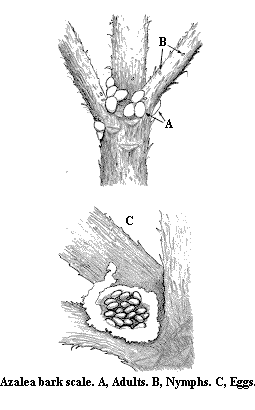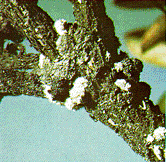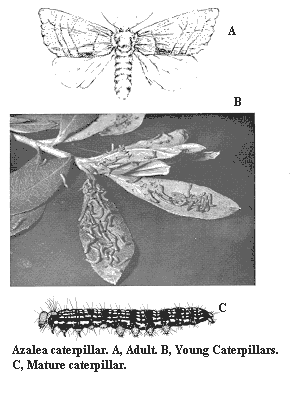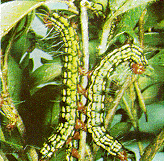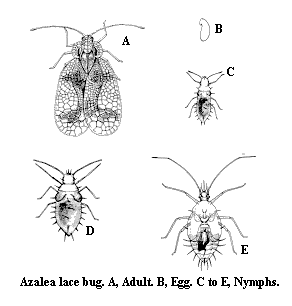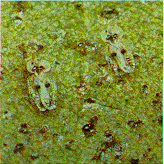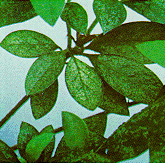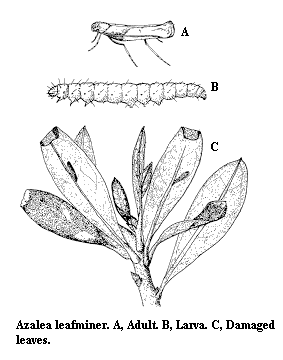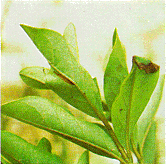Key to Azalea Pests
The azalea is one of the most popular flowering shrubs in the landscape. Each year more than 78 million azalea plants are grown in the Southeast. However, these shrubs, like most cultivated plants, are subject to attack by insect pests. The principal insects that attack azaleas in the Southeast are azalea bark scales, azalea leafminers, lace bugs, whiteflies, peony scales, thrips, and leafeating caterpillars and beetles. To this list of insects can be added several species of mites. Though they are not insects, they may occasionally be troublesome.
- Azalea bark scale – Infested azaleas usually appear chlorotic; the bushes are often covered with a black fungus; and white cottony or matted waxy, threadlike masses may be found in crotches and on twigs.
- Azalea caterpillar – The plant is defoliated or has "chewed up" younger leaves. The length of the caterpillar varies from about 10 mm (reddish to brownish black with white and yellow stripes) to about 51 mm (black with white or yellow stripes and red head).
- Azalea lace bug – The upper surfaces of the leaves are discolored in spots (mottled); the under surfaces are often dotted with "fly specks" (excrement). Also on the under surfaces of leaves are adult insects (3 mm long with brown and black markings on lacelike wings) and nymphs (small, dark, and spiny).
- Azalea leafminer (leafroller) – Brown blisters appear on leaf tips, and margins of leaves are often curled up. The small, yellow caterpillar causing the blisters is not visible because it feeds between the two leaf surfaces.
Azalea Bark Scale
Azalea bark scale, Eriococcus azaleas Comstock, Eriococcidae, HEMIPTERA
DESCRIPTION
Adult – The adult female azalea bark scale is dark red with short legs and antennae and long, sucking mouth- parts. The insect is hidden from view by the egg sac, a covering of felted or matted waxy threads (Figure B). The sac is about 3 mm long and 1.5 mm thick.
Egg – The egg is laid within the egg sac, occupying the void left by the female's shrinking body.
Nymph – The tiny nymph hatches from the egg and ventures out of the egg sac. It soon penetrates the bark with its long, sucking mouthparts and begins to feed. The nymph is inconspicuous and practically free of any waxy covering.
BIOLOGY
Distribution – The azalea bark scale occurs in the eastern United States; it has also been reported in Belgium, Germany, and Russia.
Host Plants – The azalea bark scale has been found on four azalea species, rhododendron, "flowering cherry," and huckleberry.
Damage – Since its discovery in 1881, the azalea bark scale has become recognized as a prominent pest of azaleas. Infested plants usually appear chlorotic and unthrifty. The bushes are often covered with sooty mold, a black fungus that grows in the honeydew excreted by the azalea bark scales as they feed. Eventually twigs may die back.
Life History – As the female azalea bark scale matures, it secretes white, waxy threads, which become felted or matted into a thick covering over its entire body. This covering is called the egg sac, where eggs are laid after mating. As the female lays eggs, its body shrivels gradually. A until the egg sac is almost completely filled with eggs. Eggs are laid in late April. They hatch in about 3 weeks. This new generation matures during the summer and produces eggs in September. Mature females tend to feed in crotches and on twigs. Adult males, two-winged and tiny, tend to feed on the leaves. Azalea bard scales overwinter as nymphs feeding on the bark.
CONTROL
Adult females and eggs are protected by the egg sac from virtually any pesticide. The key to control is treatment in late spring and late fall when the nymphs are present. For specific controls, see the current state extension recommendations.
Azalea Caterpillar
Azalea caterpillar, Datana major Grote and Robinson, Notodontidae, LEPIDOPTERA
DESCRIPTION
Adult – The light-brown moth has a wingspan of 45 mm.
Larva – The partly grown larva (caterpillar) is approximately 10 mm long and reddish to brownish black with white and yellow stripes. The mature caterpillar is about 50 mm long and black with eight near-white, longitudinal, broken stripes; the head and legs are mahogany red (Figure C).
BIOLOGY
Distribution – Azalea caterpillars are serious pests of azaleas in the Southeast: Virginia, the Carolinas, Florida, Alabama, Mississippi, and Louisiana.
Host Plants – An important pest of azaleas, azalea caterpillars have also been reported on blueberry in Delaware, on red oak in Maryland, and occasionally on Andromeda and apple in Atlantic states.
Damage – Often the caterpillars defoliate much of the plant before they are detected.
Life History – The azalea caterpillar is gregarious, feeding in groups; all members raise head and posterior in unison when disturbed. Comparatively little is known about the biology of this insect. Apparently there is only one generation per year. Eggs are deposited by the female moth in masses of 80 to 100 on the underside of the leaf. The first-instar caterpillars feed in a cluster side by side unless disturbed. Most of the damage occurs in August and September.
CONTROL
Because the caterpillar is harmless to humans, it can be removed by hand. For specific chemical controls, see the current state extension recommendations.
Azalea Lace Bug
Azalea lace bug, Stephantis pyrioides (Scott), Tingidae, HEMIPTERA
DESCRIPTION
Adult – The small adult, 3 mm long and 1.5 mm wide, has lacy wings with brown and black markings, and light brown legs and antennae (Figure D).
Egg – The smooth, white egg, which measures approximately 0.4 mm by 0.8 mm, is flask shaped with the neck to one side. It is usually deposited in the tissue of a young leaf along the midrib or a large vein. Each egg is inserted in the tissue with its neck slightly above the leaf surface. Up to 90 eggs have been found in a single leaf. Most of them are placed irregularly along the midrib.
Nymph – Commonly found on the underside of a leaf, the nymph is almost colorless at birth but soon turns black and spiny. It molts six times and ranges in size from 0.4 mm to 1.8 mm before becoming an adult. After the fourth molt, wing pads show distinctly.
BIOLOGY
Distribution – In the United States, the azalea lace bug occurs from New York and Massachusetts southward into Florida and Alabama.
Host Plants – The evergreen azalea varieties are preferred by azalea lace bugs, although the deciduous varieties may be attacked. Mountain laurel is also subject to infestation.
Damage – Injury is caused by the nymphs and adults as they extract sap from the undersurfaces of the leaves. The damage shows as spotted discoloration of the upper surfaces of the leaves (Figure E). In severe infestations, the leaves become almost white, many of them drying completely and dropping off. The undersides of the leaves are also disfigured by the excrement and cast skins of the insects.
Life History – Since its introduction from Japan in the early 1900s, the azalea lace bug has been recognized as an important pest of azaleas. Female lace bugs lay groups of eggs on the undersides of the leaves, most often along the midribs. This egg-laying takes place over an average period of 2 weeks. These eggs require an average of 2 weeks for hatching. Colorless at first, the spiny nymphs hatch from the eggs, gradually darken, and go through five growth stages before becoming adults. Because of the extended oviposition period, it is quite possible to find all stages together on the undersides of the leaves at the same time. Usually two or more generations are produced in a year. The insect overwinters in the egg stage. In the South these overwintered eggs start hatching in late February, building up to a dense population during March, April, and May. A second brood comes along in July, August, and September. During early August eggs are laid. By the middle and last week in September, many adults of this brood are present, the overwintering eggs being deposited at this time and during the first part of October.
CONTROL
Adult females and eggs are protected by the egg sac from virtually any pesticide. The key to control is treatment in late spring and late fall when the nymphs are present. For specific controls, see the current state extension recommendations.
Azalea Leafminer
Azalea leafminer, Caloptilia azaleella (Brants) Gracillariidae, LEPIDOPTERA
DESCRIPTION
Adult – The adult azalea leafminer is a small, yellow moth with purplish markings on the wings. The wingspan is about 10 to 13 mm.
Larva – The leaf-mining larva is yellowish and about 13 mm long. It has three pairs of prolegs found on abdominal segments three, four, and five. The proleg hooks (crochets) are singly arranged in a U-shaped pattern (penellipse) with a series of crochets within the pen.
BIOLOGY
Distribution – The azalea leafminer is found in most states where azaleas are grown.
Host Plants – Azaleas are the only known hosts for this insect.
Damage – This leafminer larva has little effect on plants grown outdoors, but it may do considerable damage to cuttings in the greenhouse. Mining within the leaf, the young larva causes the formation of brown blisters on the leaf surfaces (Figure F). As the larva matures, it emerges and rolls the edge of a leaf around itself for protection while feeding on the leaf surface. Seriously injured leaves usually turn yellow and drop, thereby causing an unslightly plant.
Life History – Eggs are deposited singly on the undersides of leaves along the midribs, usually one to five per leaf. The young (larvae) hatch in about 4 days, mine into the leaves, and feed inside them. At this stage, the leaves appear to have blisters. If a leaf is held up to the light, the larva can be seen inside. When about one-third grown, the larva emerges, moves to the tip of a new leaf, and rolls it up for protection while feeding and growing. When nearly grown, the larva rolls up the margin of a leaf and spins a cocoon inside. The moth emerges from the cocoon, mates, and deposits eggs for another generation. Under greenhouse conditions, the larvae may be found at any time during the year. The insect overwinters outdoors as a larva or pupa. Adults appear and females begin to lay eggs about the time plants bloom in the spring.
CONTROL
Because the larva protects itself by mining into and rolling the leaf, this insect is not easy to control. Several insecticide-spray mixtures have yielded satisfactory control when applied at the first sign either of the adult moth or of foliar injury by the larva. One or two applications, 1 to 2 weeks apart, are usually sufficient. For specific chemical controls, see the current state extension recommendations.
Publication date: Jan. 1, 1993
Reviewed/Revised: Aug. 9, 2024
AG-189
Other Publications in Insect and Related Pests of Shrubs
N.C. Cooperative Extension prohibits discrimination and harassment regardless of age, color, disability, family and marital status, gender identity, national origin, political beliefs, race, religion, sex (including pregnancy), sexual orientation and veteran status.

